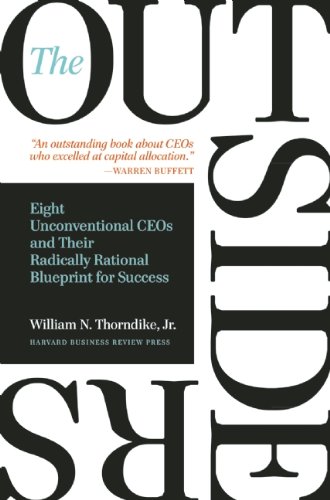

This article is an excerpt from the Shortform summary of "The Outsiders" by William N. Thorndike, Jr. Shortform has the world's best summaries of books you should be reading.
Like this article? Sign up for a free trial here .
What made General Dynamics Corporation so successful? Did the short terms of its CEOs make a difference?
General Dynamics Corporation is one of the largest and best known major companies. Discover General Dynamics’ history, how General Dynamics thrived, and how they applied lessons from one of its most successful CEOs, Bill Anders.
General Dynamics: New Vision for an Old Company
General Dynamics history shows that it is an aerospace and defense corporation. After the end of the Cold War, it and many other defense companies faced a large contraction of spending as US national defense priorities shifted. Incoming CEO Bill Anders successfully led a turnaround that made General Dynamics the industry’s profit leader, instilling fundamentals that continue to this day.
General Dynamics Performance
From 1991 to 2008, General Dynamics history showed a 23.3% annual return rate, compared to 8.9% for the S&P 500 and 17.6% for major conglomerates.
$1 invested at the beginning would have been worth $30 by 2008. This outperformed the S&P by 6.7 times, and its peers by 1.8 times.
General Dynamics History
In 1989, the Berlin Wall fell, and with it fell the US defense industry’s business model. Accustomed to selling large weapons systems such as missiles and bombers, the defense industry now found its wares obsolete amidst new national priorities. Within 6 months, the price of leading defense companies had fallen 40%.
General Dynamics’ history as a defense company meant it was one of the worst affected companies. In 1991, it had $10 billion of revenue but negative cash flow, as well as $600 million of debt, and thus had a market capitalization of just $1 billion. That year, Bill Anders joined as CEO.
Bill Anders: 1991-1994
Anders was an air force fighter pilot and astronaut who held the rank of major general at NASA and was well-respected at the Pentagon. At 45, he left government for the private sector, first for General Electric and then for conglomerate Textron. An independent thinker and blunt communicator, he was a misfit for bureaucratic cultures.
In 1989, he was made an offer to join General Dynamics company, first as vice-chairman for one year and then to rise to CEO. He spent the year studying the industry with fresh eyes, where he came upon his strategic insight: during the Cold War, defense companies had become bloated with excess capacity. Now that much of their wares weren’t needed, defense companies had two options: 1) shrink down dramatically to retain margins, or 2) acquire businesses to grow.
In turn, his strategy for General Dynamics Corporation had three key ideas:
- The company would only stay in businesses where it could be #1 and #2 (a famous Jack Welch idea).
- The company would leave commodity businesses with low returns.
- The company would stick to its strengths. Namely, it would leave commercial businesses and stick to defense and government contracts.
In his three years as CEO, Anders implemented a rigorous focus on margins and generating more cash:
- He found that the mindset of the company was to make bigger, faster weapons to grow revenue, with little care for shareholders and financial performance. He moved to instill a new mindset of financial performance, emphasizing cash return on capital.
- He made large personnel adjustments. He replaced 21 of the top 25 executives, reduced headcount by 60%, and cut corporate staff by 80%.
- He promoted Jim Mellor, a business unit head known for enforcing results, to COO.
- He and Mellor tightened operations by reducing inventory and capital equipment. They found a systemic problem of excess inventory (for instance, having dozens of F-16 plane canopies in a facility that made just one plane a week) as well as duplicate machinery.
These moves produced fantastic returns—$2.5 billion in cash, and a market-leading return on assets.
The other major move Anders employed was selling non-core businesses to other defense companies. He found that competitors were willing to pay premium prices to grow their businesses. Within two years, Anders sold the majority of their business lines, including their F-16 fighter plane division to Lockheed for $1.5 billion. This was unprecedented in the defense industry, and certainly unheard of in General Dynamics history—observers say Anders was only able to do this because of his credibility in Washington as a military veteran. These sales generated another $2.5 billion in cash.
What to do with this extra $5 billion in cash? Anders made two moves:
- He paid special dividends to shareholders worth about half of the company’s market capitalization. Even better, because they came from the sale of business units, they were deemed “return of capital” and weren’t taxed as capital gains or ordinary income.
- He used $1 billion to repurchase 30% of company shares.
All of these moves—the generation of billions in cash, and its return to shareholders for the first time in recent General Dynamics history—made the stock price shoot up.
After serving as 3 years as CEO, Anders handed the reins to his COO, Jim Mellor.
Jim Mellor: 1994-1997
Mellor continued discipline around operational excellence and selling the last non-core business units.
However, in 1995 he made an uncharacteristic move by buying a navy ship builder for $400 million. After years of the company shrinking, he had kicked off a new era of General Dynamics history—one of growth.
After 3 years as CEO, Mellor handed the reins to the company’s general counsel and a key facilitator of Anders’s strategy, Nick Chabraja.
Nick Chabraja: 1997-2008
Chabraja set a lofty goal for himself as CEO—grow the stock price by 4-fold in ten years (a 15% annual return). He figured the majority of this could come through market growth and improved operations. The rest had to come through acquisitions.
While this departed from Anders’s actions, the fundamental beliefs were the same—General Dynamics Corporation should grow only in core businesses it knew well. Chabraja began with small acquisitions, adding onto its information technology, tank production, and marine divisions.
In 1999, he made his hallmark move, the $5 billion purchase of Gulfstream, the largest commercial jet manufacturer. The acquisition was equal to 56% of the enterprise value of General Dynamics, one of the most significant in General Dynamics history.
Observers criticized the move as departing from Anders’s 3-point strategy from 1991, but Chabraja had a deeper logic—Gulfstream had stagnated in product development. In contrast, General Dynamics had considerable experience in aircraft from its previous days, and this expertise could be used to grow Gulfstream. In turn, Gulfstream would help diversify General Dynamics company away from the fluctuations in military defense spending.
In an unusual move for outsider CEOs, Chabraja sold stock to fund the purchase of Gulfstream. However, his logic was that General Dynamics was trading at all-time highs (23 times projected earnings, vs. the recent average of 16). He could sell ⅓ of the company to buy a business that would contribute half of its cash flow—a clear profitable arbitrage.
When Chabraja retired from CEO in 2008, he had more than achieved his goal of quadrupling their stock price. Importantly, the three CEOs left a legacy of fundamental ideals—General Dynamics leads in all its business lines, and it has the industry’s highest return on assets and margins.
Though Bill Anders only served as CEO for three years, his decisions and policies affected his successors as well. Unlike many CEOs, the CEOs of General Dynamics didn’t let ego drive their business- Anders took the risk of shrinking back the company for the sake of shareholder value, a decision that paid off down the line.

———End of Preview———
Like what you just read? Read the rest of the world's best summary of William N. Thorndike, Jr's "The Outsiders" at Shortform .
Here's what you'll find in our full The Outsiders summary :
- What great CEOs like Warren Buffett do that average CEOs don't
- How to master the art of capital allocation
- How to be a great manager that your team is excited to work with






